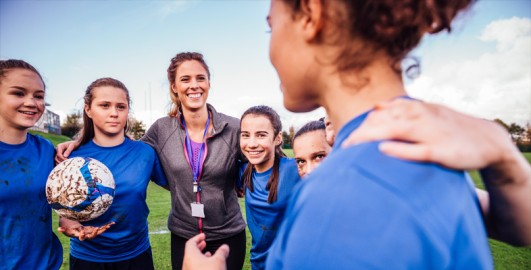2 Putting a strengths-based approach into practice
Discourse around wider disability sport has been hindered by a lack of reference to neurodiversity, and wider disability sport within coach education frameworks (Townsend et al., 2022). This means coaches across a range of sports may feel underprepared to coach athletes with these additional needs. Again, this is rooted in a deficit model of viewing these athletes, potentially limiting the support being offered by coaches and furthering ableist narratives. While this may at first seem bleak, in the same way as you have explored the importance of strengths-based approaches for neurodivergent individuals, we can apply this to coaching practice.
Townsend et al. (2022) propose a model for furthering coaching practice, with their ‘social-relational model’ containing four components to guide development in this area. Each component is covered in turn below (adapted from Townsend et al., 2022):
Activity 3 Applying a social-relational model to practice
For each component of the social-relational model outlined above, think about how someone like Lucy Bronze could experience them. You can use some of Lucy’s comments in the clip from Section 1 to help you but also think about your wider learning of the course so far and how that could apply to Lucy. Once you have completed the middle column, note down how coaches could turn some of these experiences intro strengths. An example is given in the first row to help you get started
| Component | Possible experiences for Lucy | Potential strengths for Lucy |
| Impairment effects | Lucy’s neurodivergence means she is sometimes viewed as a ‘know it all’ by others | Lucy’s neurodivergence means she is always very focused on training drills |
| Relational practices | ||
| Structural barriers | ||
| Psycho-emotional dimensions |
Comment
This activity helped you explore the different ways athletes can present in coaching settings, and how you can turn these into strengths. Some suggestions for the remaining 3 sections of this model are below, but you may have come up with some slightly different ones too.
| Component | Possible experiences for Lucy | Potential strengths for Lucy |
| Impairment effects | Lucy’s neurodivergence means she is sometimes viewed as a ‘know it all’ by others | Lucy’s neurodivergence means she is always very focused on training drills |
| Relational practices | Some coaches may treat everyone the same, meaning elements of communication which she may find hard are misperceived as being difficult or disrespectful | Coaches can utilise the strengths of an athletes neurodivergence by making adjustments to how they communicate with them |
| Structural barriers | Lucy may have struggled getting to new training facilities or away matches | Coaches could use Lucy’s determination to succeed in a positive way by helping plan transport routes to new venues |
| Psycho-emotional dimensions | If an athlete like Lucy does not feel supported or being part of a safe space, their wellbeing may be impacted | Coaches can find ways to help an athlete like Lucy feel comfortable in social situations. This could be using headphones to block out external noise, or sitting in the same place for team meetings |
Your completed table can be used as part of your session planning process, to keep neurodiverse needs as a key focus in your practice. The coaching environment created is essential for a strengths-based approach to be successful, with a big part of this being informed by how ‘safe’ athletes feel to be themselves and not have to mask their experiences.
The next section explores the concept of safe spaces in more detail.
